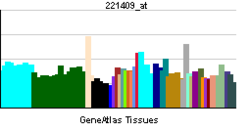- OR2S2
-
Olfactory receptor, family 2, subfamily S, member 2 Identifiers Symbols OR2S2; OR37A; OST715 External IDs HomoloGene: 84331 GeneCards: OR2S2 Gene Gene Ontology Molecular function • receptor activity
• olfactory receptor activityCellular component • plasma membrane
• integral to membraneBiological process • sensory perception of smell
• response to stimulusSources: Amigo / QuickGO RNA expression pattern 
More reference expression data Orthologs Species Human Mouse Entrez 56656 29849 Ensembl ENSG00000122718 ENSMUSG00000044801 UniProt Q9NQN1 n/a RefSeq (mRNA) NM_019897 NM_019476.1 RefSeq (protein) NP_063950 NP_062349.1 Location (UCSC) Chr 9:
35.96 – 35.96 MbChr 4:
43.78 – 43.78 MbPubMed search [1] [2] Olfactory receptor 2S2 is a protein that in humans is encoded by the OR2S2 gene.[1]
Olfactory receptors interact with odorant molecules in the nose, to initiate a neuronal response that triggers the perception of a smell. The olfactory receptor proteins are members of a large family of G-protein-coupled receptors (GPCR) arising from single coding-exon genes. Olfactory receptors share a 7-transmembrane domain structure with many neurotransmitter and hormone receptors and are responsible for the recognition and G protein-mediated transduction of odorant signals. The olfactory receptor gene family is the largest in the genome. The nomenclature assigned to the olfactory receptor genes and proteins for this organism is independent of other organisms.[1]
Contents
See also
References
Further reading
- Strotmann J, Hoppe R, Conzelmann S, et al. (1999). "Small subfamily of olfactory receptor genes: structural features, expression pattern and genomic organization". Gene 236 (2): 281–91. doi:10.1016/S0378-1119(99)00275-9. PMID 10452948.
- Fuchs T, Malecova B, Linhart C, et al. (2003). "DEFOG: a practical scheme for deciphering families of genes". Genomics 80 (3): 295–302. doi:10.1006/geno.2002.6830. PMID 12213199.
- Strausberg RL, Feingold EA, Grouse LH, et al. (2003). "Generation and initial analysis of more than 15,000 full-length human and mouse cDNA sequences". Proc. Natl. Acad. Sci. U.S.A. 99 (26): 16899–903. doi:10.1073/pnas.242603899. PMC 139241. PMID 12477932. http://www.pubmedcentral.nih.gov/articlerender.fcgi?tool=pmcentrez&artid=139241.
- Hoppe R, Breer H, Strotmann J (2004). "Organization and evolutionary relatedness of OR37 olfactory receptor genes in mouse and human". Genomics 82 (3): 355–64. doi:10.1016/S0888-7543(03)00116-2. PMID 12906860.
- Malnic B, Godfrey PA, Buck LB (2004). "The human olfactory receptor gene family". Proc. Natl. Acad. Sci. U.S.A. 101 (8): 2584–9. doi:10.1073/pnas.0307882100. PMC 356993. PMID 14983052. http://www.pubmedcentral.nih.gov/articlerender.fcgi?tool=pmcentrez&artid=356993.
- Humphray SJ, Oliver K, Hunt AR, et al. (2004). "DNA sequence and analysis of human chromosome 9". Nature 429 (6990): 369–74. doi:10.1038/nature02465. PMC 2734081. PMID 15164053. http://www.pubmedcentral.nih.gov/articlerender.fcgi?tool=pmcentrez&artid=2734081.
- Gerhard DS, Wagner L, Feingold EA, et al. (2004). "The status, quality, and expansion of the NIH full-length cDNA project: the Mammalian Gene Collection (MGC)". Genome Res. 14 (10B): 2121–7. doi:10.1101/gr.2596504. PMC 528928. PMID 15489334. http://www.pubmedcentral.nih.gov/articlerender.fcgi?tool=pmcentrez&artid=528928.
External links
This article incorporates text from the United States National Library of Medicine, which is in the public domain.
Class II
(tetrapod specific receptors)Family 1Family 2A1 · A2 · A4 · A5 · A7 · A12 · A14 · A25 · A42 · AE1 · AG1 · AG2 · AJ1 · AK2 · AP1 · AT4 · B2 · B3 · B6 · B8 · B11 · C1 · C3 · D2 · D3 · F1 · F2 · G2 · G3 · G6 · H1 · H2 · J1 · J2 · J3 · K2 · L2 · L3 · L5 · L8 · L13 · M2 · M3 · M4 · M5 · M7 · S2 · T1 · T2 · T3 · T4 · T5 · T6 · T8 · T10 · T11 · T12 · T27 · T29 · T33 · T34 · T35 · V1 · V2 · W1 · W3 · W5 · Y1 · Z1
Family 3Family 4Family 5Family 6Family 7Family 8Family 9Family 10Family 11Family 12Family 13Categories:- Human proteins
- Transmembrane receptor stubs
- G protein coupled receptors
Wikimedia Foundation. 2010.
